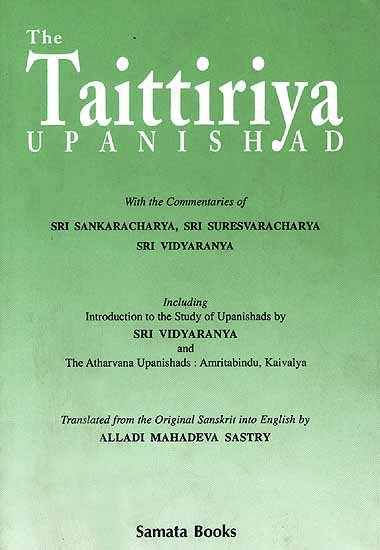Taittiriya Upanishad Bhashya Vartika
by R. Balasubramanian | 151,292 words | ISBN-10: 8185208115 | ISBN-13: 9788185208114
The English translation of Sureshvara’s Taittiriya Vartika, which is a commentary on Shankara’s Bhashya on the Taittiriya Upanishad. Taittiriya Vartika contains a further explanation of the words of Shankara-Acharya, the famous commentator who wrote many texts belonging to Advaita-Vedanta. Sureshvaracharya was his direct disciple and lived in the 9...
Verse 2.298
Sanskrit text and transliteration:
एवं च सति नित्यत्वं वेदानां घटतेऽञ्जसा ।
वाचकत्वमशब्दस्य सिद्धं न स्फोटरूपतः ॥ २९८ ॥
evaṃ ca sati nityatvaṃ vedānāṃ ghaṭate'ñjasā |
vācakatvamaśabdasya siddhaṃ na sphoṭarūpataḥ || 298 ||
English translation of verse 2.298:
Only if it is explained in this way, the eternality of the Vedas is truly justifiable. Revelation (of dharma; etc.) by the Vedas which are not external sounds is established (in this way), but not so from the sphoṭa.
Notes:
If the Ṛg and other mantras are viewed as mental states, not only is japa possible, but it can also be proved that the Vedas are eternal. It was stated earlier that the mantras are particular mental states and that the mental states are pervaded or illumined by the consciousness of the Self. The eternal consciousness which is limited by, or reflected in, certain mental states comes to be viewed as the Yajus, etc. That is to say, the Yajus, etc, are one with the consciousness which has neither a. beginning nor an end. The mind and its different states which are superimposed on Brahman-Ātman are non-different from it. So, as identical with Brahman-Ātman, the Yajus, etc., which are mental states, are eternal. Though these mental states are one with the Self, they are referred to differently as the Yajur-veda, the Ṛg-veda arid so on, because of the difference arising from the mental modes which serve as the limiting adjuncts (yajurādi-bhedastūpādhinimitta-vṛttibheda-kalpitaḥ).
The eternal Vedas which arc not to be treated as an aggregate of external, insentient sounds are our source of knowledge in respect of dharma and adharma. The grammarian philosophers who subscribe to the theory of sphoṭa argue that the Veda conveys its meaning only through sphoṭa. According to them, a word which is uttered conveys its meaning through an unperceived, partless, unitary symbol called sphoṭa. The different letters of a word reveal this latent symbol to the mind as they are uttered in succession one after another; and this symbol called the sphoṭa, which is different from the letters, directly presents the meaning of the word. So a word does not directly convey its meaning, but it only serves to arouse the symbol (sphoṭa) which conveys the meaning.
There is no need, according to Advaita; to postulate sphoṭa for the purpose of explaining how the meaning of a word is grasped at one moment, even though the letters of a word come into consciousness one after another. It is true that the letters of a word are uttered in succession one after another, and that they are perceived one by one. But the unitary meaning which a word conveys can be explained in terms of the function of the mind which has the power of synthesizing the different elements which were, originally perceived at different moments of time. A word, whether secular or scriptural, which is nothing but consciousness delimited by the mental mode conveys its meaning, and the unitary meaning of a word is grasped by the intellect which is illumined by the consciousness. And so there is no need for sphoṭa at all (arthāvabodhasya vṛttyupahita-caitanyātmakena padena vākyena laukikena vaidikena vā sambhavāt, nārthāvabodhanārthaṃ varṇātiriktaḥ kaścit sphoṭo nāma abhyugantavyaḥ). Further, there is no evidence (pramāṇa) for the existence of sphoṭa.
